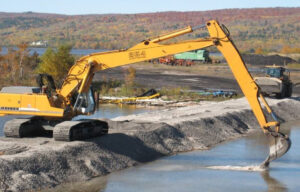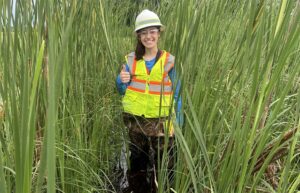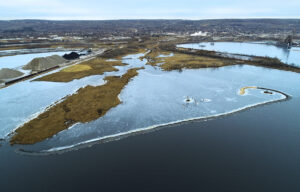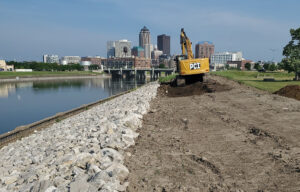Cost of removal and destruction of PFAS from wastewater effluent

Based on our two decades of experience assisting clients with per- and polyfluoroalkyl substances (PFAS) assessment, Barr was recently commissioned by the Minnesota Pollution Control Agency (MPCA) to evaluate currently available alternatives for PFAS removal and destruction from water resource recovery facility (WRRF) effluent, WRRF biosolids, mixed municipal solid waste landfill leachate, and compost contact water (waste streams). We engaged Hazen and Sawyer, a water, wastewater, and stormwater management firm, to analyze PFAS destruction in biosolids. The study includes estimated operations and maintenance (O&M) and capital cost curves related to these activities.
Our work also included development of a peer-reviewed journal manuscript titled “Is removal and destruction of perfluoroalkyl and polyfluoroalkyl substances from wastewater effluent affordable?” The research article was published in the January 2024 issue of Water Environment Research, an international multidisciplinary water resource management journal for the dissemination of fundamental and applied research in all scientific and technical areas related to water quality and resource recovery.
Below is an expert from the journal publication. Read the full article in the January 2024 issue of Water Environment Research (or access the PDF below).
Is removal and destruction of perfluoroalkyl and polyfluoroalkyl substances from wastewater effluent affordable?
The accumulation and persistence of PFAS in the environment present a global environmental challenge. PFAS are ubiquitous globally in environmental media and continuously distributed through hydrologic and atmospheric processes (Cousins et al., 2022; Evich et al., 2022). In addition, their environmental degradation to non-PFAS end products is limited (Prevedouros et al., 2006; Wang et al., 2017). This environmental persistence, coupled with their ongoing production and widespread use, means that the mass of PFAS present in the global environment continues to grow (Cousins et al., 2022), with potential health impacts for future generations (Sunderland et al., 2019).
This increasing focus on PFAS in WRRF effluent and potential for increased use of NPDES permit limits to restrict them reflect increasing concern around their environmental persistence and potential toxicity. Many studies have focused on the technical feasibility of removing of PFAS from environmental media (Berg et al., 2022; Jin et al., 2021; Liu & Sun, 2021). A few have included detailed cost estimates to remove and destroy PFAS, including recent studies on drinking water (Black & Veatch, 2023) and landfill leachate (Malovanyy et al., 2023). However, none have done so with a focus on WRRF effluent, where economic affordability is a key consideration in permit limit compliance and infrastructure funding availability.
This study begins to address the literature gap by estimating costs to retrofit existing WRRFs to separate and destroy PFAS from WRRF effluent using effective technologies currently applied at relevant scales.
This study begins to address the literature gap by estimating costs to retrofit existing WRRFs to separate and destroy PFAS from WRRF effluent using effective technologies currently applied at relevant scales. Costs include tertiary treatment retrofits needed to limit fouling of primary PFAS separation technologies. Estimated costs per household served were compared to U.S. EPA affordability metrics, using Minnesota WRRFs as an example case, to inform potential changes in utility rate affordability and impacts to rate payers.
Continue reading the full, open-access article in the January 2024 issue of Water Environment Research (or access the PDF below).
About the authors
Becca Vermace, environmental engineer, has five years of experience with water and wastewater engineering projects and research and a master’s degree in environmental engineering. At Barr, Becca has worked on a variety of projects for industrial and municipal clients. Her work has focused on feasibility studies and designs of system retrofits to help clients come into compliance with their permit limits and achieve water quality goals. Many of her projects have been for clients trying to remove per- and polyfluoroalkyl substances (PFAS) from drinking water, wastewater, or stormwater.
Andy McCabe, environmental engineer, has experience with civil engineering, including working on a variety of projects for industrial and municipal clients, several of which are aimed at treating per- and polyfluoroalkyl substances (PFAS). He has worked on a variety of other projects relating to emerging contaminants, industrial water treatment, water reuse and alternative water sources, and analysis of environmental monitoring data.
Katie Wolohan, senior environmental engineer, has more than 12 years of environmental consulting experience and assists clients with industrial and municipal water and wastewater treatment, water reuse, and environmental compliance and permitting. She works with clients to navigate water and wastewater treatment challenges and options from conceptual design and bench and pilot testing through full-scale system start-up. Katie has assisted with the evaluation, design, and implementation of several water treatment systems, including a specialized acid-recovery ion-exchange system, an advanced oxidation process system for the removal of 1,4-dioxane from drinking water, and multiple per- and polyfluoroalkyl substance (PFAS) treatment systems.
Other contributing authors: Alison L. Ling, Scott J. Kyser








